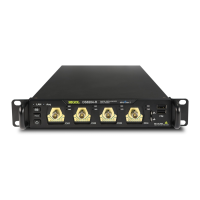RIGOL Chapter 12 Reference Waveform
12-6 DS8000-R User Guide
2. Waveform Header
It is possible to store several waveforms in the file. Each stored waveform has a
waveform header. When several channels are stored, each channel can be
considered as a separate waveform. The waveform header contains the
information about the type of waveform data that are stored following the
waveform data header.
A 4-byte integer, indicating the number of bytes in the
header.
A 4-byte integer, indicating the type of the waveform stored
in the file.
0 = Unknown
1 = Normal
2 = Peak Detection
3 = Average
4 = Not Used
5 = Not Used
6 = Logic
Number of
Waveform
Buffers
A 4-byte integer, indicating the number of waveform buffers
required to read the data.
A 4-byte integer, indicating the number of waveform points in
the data.
A 4-byte integer, indicating the number of hits at each time
interval during waveform recording when using a certain
sample mode (e.g. Average) to create the waveforms. For
example, when averaging, a count of 4 indicates that each
waveform data point in the waveform recording has been
averaged at least 4 times. The default value is 0.
A 4-byte float, indicating the X-axis duration of the waveform
that is displayed. For time-domain waveforms,
it indicates the duration of time across the display. If the
value is zero, then no data has been acquired.
A 8-byte double, indicating the X-axis value at the left edge of
the screen. For time-domain waveforms, it indicates the time
at the start of the display. The value is treated as a double
precision 64-bit float point number. If the value is zero, then
no data has been acquired.
A 8-byte double, indicating the duration between data points
on the X axis. For time-domain waveforms,
it indicates the time between points. If the value is zero, then
no data has been acquired.
A 8-byte double, indicating the X-axis value of the first data
point in the data recording. For time-domain waveforms, it
indicates the time of the first point. The value is treated as a

